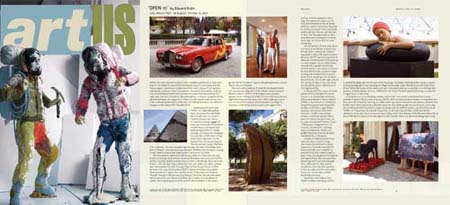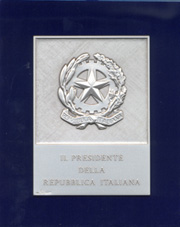Paolo De Grandis in CINA
Il presidente di "Arte Communications", Paolo De Grandis, su invito del governo cinese, è volato in Cina . Il curatore di "Open" stato chiamato a presenziare alla conferenza introduttiva che si sta tenendo in questi giorni nella città di Chengdu, capoluogo della provincia dello Sichuan, per un progetto culturale di vaste dimensioni che prevede la creazione di un Centro Internazionale per l'Arte Contemporanea e che include la prima Biennale Internazionale che si terrà a ottobre 2010. Un progetto culturale, su scala internazionale, che mira a segnare un record, sia in termini fisici che teorici. Inoltre ci sarà la creazione di otto musei, che saranno inaugurati nel mese di ottobre 2008, dedicati ai maggiori artisti cinesi che si stanno imponendo sulla scena internazionale. Paolo De Grandis, che collabora con la Biennale di Venezia dal 1995, in qualità di curatore e commissario per la presentazione di nuove partecipazioni internazionali, ed è stato il precursore nel presentare per la prima volta i paesi asiatici all'Esposizione Internazionale d'Arte istituendo inoltre i nuovi padiglioni fuori dalle aree canoniche dei Giardini e dell'Arsenale. Un sodalizio, quello con l'Oriente che trova sbocco in questo progetto culturale di grande importanza e che lo vedrà coinvolto in qualità di curatore e membro del comitato scientifico nonché di quello organizzativo. L'idea di legare ad un Centro per l'Arte Contemporanea, una mostra a cadenza biennale è una questione di identità culturale e non solo geografica. La Biennale di Chengdu diventerà dunque una straordinaria vetrina, la dichiarazione di una volontà e di una disposizione al dialogo e al confronto con l'esterno.
OPEN recensito da ArtUS

Venice: Open 10
International Exhibition of Sculptures and Installations
By Edward Rubin
OPEN, the International Exhibition of Sculptures and Installations held each year on the island of Lido where the Adriatic Sea, the landscape and the Venice lagoon meet is one of the most unique, not to mention romantically heady, outdoor/indoor art exhibitions in the world. Essentially a walking tour, the exhibition starts the moment the viewer disembarks from the vaporetto onto the Piazzale St. Maria Elisabetta, continues along the lushly planted walkways of Lungomare G. Marconi, the island’s main street, and ends overlooking the beach at the very chic Hotel Westin Excelsior, the infamous hangout of the Venice Film Festival crowd.
Celebrating its tenth year, the curators of this year’s OPEN 10, founder Paolo De Grandis and Carlotta Scarpa, chose to return to their beginnings by inviting a gaggle of art stars — those who appeared in earlier OPEN exhibitions — to exhibit alongside the forty or so, mostly younger and unsung artists. Strangely (or not) the big name artists like Enzo Cucchi, Sandro Chia, Christo and Jeanne Claude, contributed work that seemed to be pulled right out of their dustbins. The sole exception was eighty-five year old New York/Italy artist Beverly Pepper’s astonishing Longo Monolith (2006), a two pronged, curving corten steel sculpture that rivals Richard Serra at his very best.
The first work to catch and hold my eye, albeit for a few seconds, was B.Zarro’s, ironically slick and oh so trendy, Manifesto Postcomunista (1974-2005). Casually parked outside a luxury hotel, a shockingly shiny red Rolls Royce, one side sporting a yellow hammer and sickle, the other a yellow star, trumpeted the new moneyed faces of Russia and China. Further on down the road, Acid Gardens (2007), Italian artist Resi Girardello’s intricately woven copper wire castles, spoke of fairy tales and dreams. Though resting on the ground, according to the artist, the two delicately fashioned castles were meant to be suspended in mid air. Surrounding the castles, and supplying much of the acid in the installation’s title, were a garden full of Christina Treppo’s phosphorescently colored fabric vines and flowers.
The most philosophically cum scientifically based installation on view was Republic of San Marino artist Leonardo Blanco’s Nature (2007). At first glance we see what appears to be nothing more than a forest of thickly planted, eight foot, vertical steel poles. After walking around the 13 foot square installation, through the weave of the vertical poles, and this barely and only at certain angles, we see the outline of what appears to be a dog. The lesson the artist successfully demonstrates is that reality, visual and presumably otherwise, depends on where you stand. Those passerby’s briskly taking in the air, perhaps lost in their own thoughts, had no idea at what they were looking at. To most, there was no forest and no dog.
On the portico of Hotel Des Bains, the hotel where Death in Venice was filmed, Dutch artist Jackie Sleper’s exquisitely crafted, life-sized sculpture Modesty (2007) was turning heads. Here a bluish purple horse grazes among a bed of giant red porcelain roses. Atop the horse is a golden-haired boy-child drinking in the beauty of nature. Directly behind the sculpture hangs an elegantly rendered painting of a white horse standing in an Arcadian field of clover. Across the right side of the canvas, written in her own hand, are the artist’s poetic reflections on the fragility of life.
In Psyche (2007), a series of white plaster torsos, arranged like tombstones in an abandoned cemetery, Italian artist Barbara Taboni, offered the exhibition’s only interactive installation. People were given colored pencils so that they could leave a sign of their passing — some even drew little pictures — on the torso of their choice. I could not help but feel a sense of melancholy wash over me as I was reminded of Thomas Gray's poem, An Elegy Written in a Country Churchyard , that no matter how colorful our graffiti filled lives may be, all paths but lead to the grave. Unique, in material alone, if not idea, was Swiss sculptor (he also is an engineer) Heinz Aeschlimann’s darkly mysterious pyramids titled Piramide Fuso (2007). Experimentally cast in asphalt (a first?) the materials used to pave roads, and peppered throughout with glass shards, the two pyramids, appearing both wise and strangely alive, reflected the daily weather conditions. One day they sparkled in the noonday sun, the next, under heavy rain clouds, they turned absolutely ominous.
Standing in the lobby of the Hotel Westin Excelsior was Bang (2002) two of Chinese artist Xiang Jing's haunting fiberglass painted figures. Tauntingly challenging the viewer, a widely smiling teenage girl is seen pointing her finger, menacingly in gun-like fashion, at the head of her friend. While the scene can be read as two girls innocently playing, in actuality it is a chilling reenactment of Eddy Adams's 1968 world famous photo of a South Vietnam general shooting a young Viet Cong prisoner in the head. Ending the tour on a somewhat upbeat note is New York artist Carole Feuerman's supra-realistic sculpture The Survival of Serena (2007). With simulated beads of water running down her face, and tufts of real hair sticking out of her swim cap, we are relieved to see Serena, overwhelmed by life, if not nearly drowning as the title seems to infer, floating safe and sound in an inner tube. As to be expected, Feuerman's sculpture, always popular with the public, was the photo op of OPEN 10. Feuerman, with her decade's long career on an upswing, also had a small but choice exhibition of her early work (curated by John Spike, the former director of the Florence Biennale), running at the In Paradiso Gallery at the Giardini adjacent to the Venice Biennale. Here too the shutterbugs, acting as if they were "By The Sea" the title of her exhibition, were going crazy snapping photos of each other in front of her work.
Edward Rubin is an Editorial Correspondent for Art & Antiques. His work appears regularly in such publications as Art & Antiques, Contemporary, Sculpture and ArtUS magazines.
Targa Presidente della Repubblica

Lettera proveniente dalla Segreteria Generale della Presidenza della Repubblica
Egregio Sig. De Grandis,
ho il piacere di informarla che il Presidente della Repubblica ha voluto destinare una Targa alla X edizione dell'Esposizione Internazionale di Sculture ed Installazioni "Open2007".
Nell'inviarle il riconoscimento mi è gradito farLe giungere l'augurio per il successo della manifestazione, insieme con un cordiale saluto.
OPEN PISANI 2006
Fonte: http://www.vettorpisani.net/openpisani/index.html
L’attività di laboratorio della nostra classe si è ispirata quest’anno alla Mostra Open 2006, che abbiamo visitato con la guida dei nostri professori a settembre, percorrendo in bicicletta i viali alberati e i luoghi principali in cui erano esposte le opere d’arte contemporanea, realizzate da artisti di provenienza internazionale, in occasione della 63. Mostra del Cinema.
In primavera l’expo di Paolo De Grandis si trasferisce a Shangai
Considerata dal Giornale dell’Arte tra le cinque mostre internazionali più importanti al mondo, Open 10 ha chiuso domenica. Due mesi e mezzo di happening artistico, fra le strade, i giardini, l’acqua e i lampioni del Lido nel bel mezzo anche della Mostra del Cinema; e la prossima primavera avrà nuovi allestimenti. L’idea, già peraltro molto avanzata, di Paolo De Grandis, inventore e organizzatore di Open, è quella di creare un’altra esposizione simile a quella veneziana a Shangai, il che equivale a pensare in grande, dai tutto sommato piccoli spazi del Lido ai numeri esageratamente grandi della Cina. Il Paese si sta muovendo alla grande verso l’arte contemporanea, tanto che i suoi giovani artisti raggiungono cifre iperboliche neanche confrontabili con quelle dei colleghi europei. Ma cos’è piaciuto di più quest’anno? Senz’altro la festa di inaugurazione all’aeroporto Nicelli, dove l’artista Marco Nereo Rotelli ha reinventato un vero bunker per la sua installazione, «Il sogno di Eva Braun», con serie di disegni, chiodi e manifesti, al cui interno una violinista moldava suonava musiche molto tristi. O ancora la Rolls Royce che viaggiava allegramente qua e là, con falce e martello dipinti di giallo sulla carrozzeria rossa o le sculture di due artisti indiani, il gigantesco Ganeshi nel parco del Des Bains o il gorilla a Santa Maria Elisabetta. Funziona quindi la filosofia del portare l’arte alla gente, negli spazi in cui vive, lavora o passeggia, con l’isola che ogni anno si trasforma in una grande galleria all’aperto, un luogo idoneo per chi ha qualcosa da dire in campo artistico, più o meno comprensibile, più o meno piacevole. (Alessandra Artale)